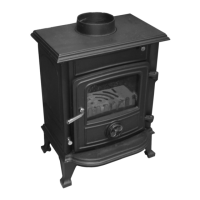12
Parts & Service: 020 8988 7400 / E-mail: Parts@clarkeinternational.com or Service@clarkeinternational.com
INSPECTION & CLEANING
Check that the chimney is in good condition, dry and free from cracks and
obstructions. The diameter of the chimney should not be less than 150mm and
not more than 230mm. If any of these requirements are not met, the chimney
should be lined by a suitable method.
The chimney must be swept before connection to the stove. Where the
chimney is believed to have previously served an open fire installation, it is
possible that the higher flue gas temperature from the stove may loosen
deposits that were previously firmly adhered, with the consequent risk of flue
blockage. It is therefore recommended that the chimney be swept a second
time within a month of regular use after installation.
Assuming that when the stove is first installed, the chimney is clean, and sound,
then the chimney flue should be inspected part way through the burning
season to establish the regularity of sweeping required. If you have any doubts
about the suitability of your chimney, consult your local dealer/stockist.
If there is no existing chimney, then a prefabricated block chimney in
accordance with Building Regulations Approved Document J, or a twin-
walled insulated stainless steel flue to B.S.4543 can be used. These chimneys
must be fitted in accordance with the manufacturer’s instructions and Building
Regulations.
FLUE DRAUGHT
A flue draught of approx 12 Pa is required for satisfactory stove performance.
The flue draught should be checked under fire at high output. If it exceeds the
recommended maximum, a draught stabiliser must be fitted so that the rate
of burning can be controlled to prevent over-firing. If the reading is less than
the recommended minimum, then the performance of the stove will be
compromised.
AIR FOR COMBUSTION
Any room or space containing a stove should have a permanent air vent
opening of at least the sizes shown in the table below. For stoves designed to
burn a range of different solid fuels, the air supply should be designed to
accommodate burning the fuel that produces the highest heating output.
There must always be a permanent means of providing air for combustion into
the room in which the fire is installed. A permanent vent with a total free area
of at least 550mm
2
for every kW rated above 5kW should be connected
directly to the outside air or an adjacent room which itself has a permanent
vent of the same size direct to the outside air.
The fitting of an extractor fan to either of these rooms is not permitted.

